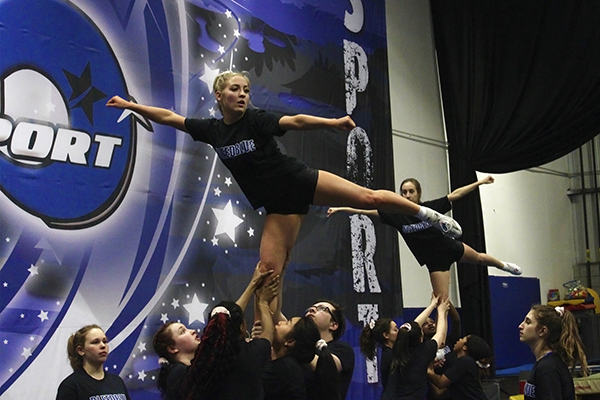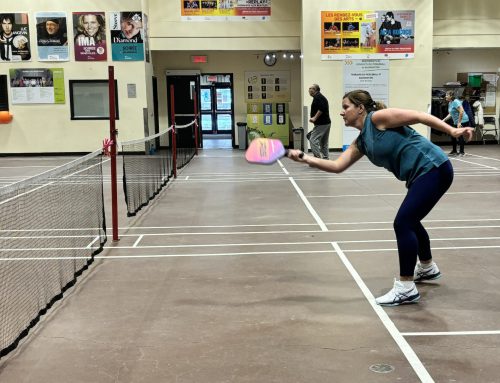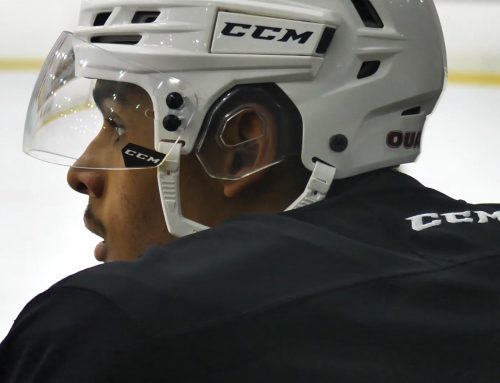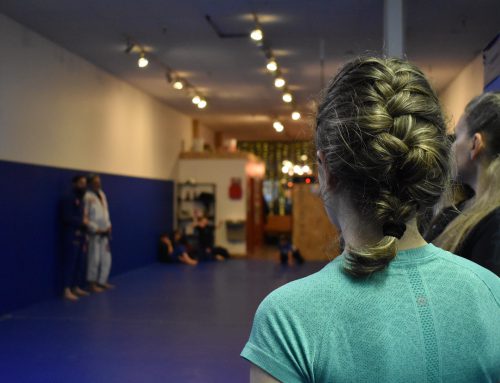BY Eithne Lynch & Alexandre Ross
Andréanne Boudreault has been cheerleading for six years, and has been training at the Flyers All-Starz gym for the past three. She started in gymnastics and dance, which helped her transition to cheer.
“A lot of people that don’t know anything about this sport think we’re the Pom-Pom girls that we see in movies during a football game,” says Boudreault. “Competitive cheer is not like that at all.”
As the Dawson College cheerleaders trickle into practice, there’s a buzz of laughter and chitchat in the air. But once it’s time to go through their routine, their game faces are on.
“You’re throwing a human who’s probably just about the same weight as you; if you take these girls and put them in a gym they probably can’t bench press that weight but they have to lift it, throw it, catch it,” explains Dawson’s head cheerleading coach, Kimberly Emond.
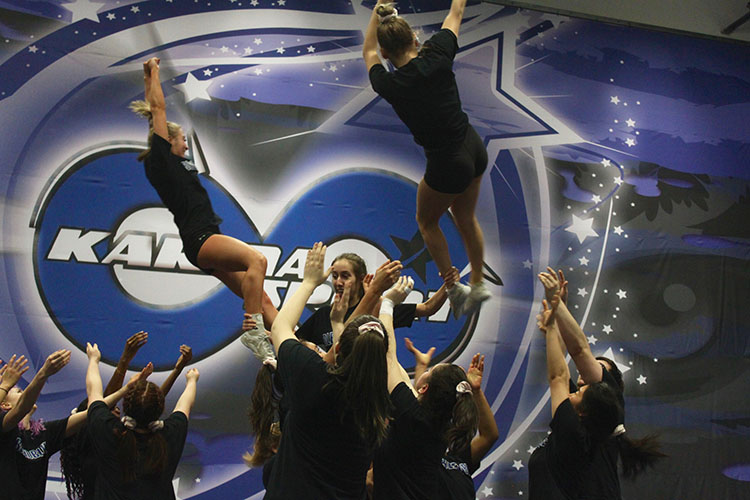
Dawson College’s Cheerleading team practices their stunts late into the evening. They toss and catch their flyers in sync to the music. Photo by Eithne Lynch.
“If you think it’s not hard, that it’s not a sport, just try it, and we’ll talk after,” says Ashley Ethier, captain of the Dawson College cheer team.
Many people hear the word cheerleading and automatically envision girls in matching outfits dancing on the sidelines and cheering for their school’s basketball or football team. That isn’t the case in competitive cheer.
“We don’t actually go to any other team sports,” said Emond. “We use our own practice time to prepare for our own competitions, and we’ve gone to nationals three years in a row.”
According to Emond, the sport of cheerleading is a lot more dangerous than many people realize.
“It is the contact sport with the most concussions, and that includes football,” she says. “I mean football has helmets, they have some type of protection. We have nothing. They’re throwing a ball, we’re throwing humans.”
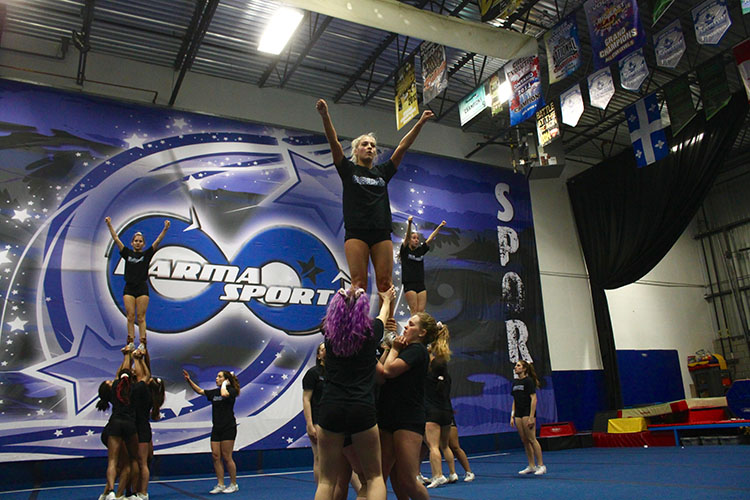
Three “flyers” are lifted and supported by their bases. These girls will be tossed into the air and must hold poses while team members hold only their feet and ankles. Photo by Eithne Lynch.
Ethier says she’s suffered at least two concussions while cheerleading, one of them being fairly severe. However, she noted that there is a chance that she has had minor concussions in the past that went undiagnosed and which made her symptoms worse.
She says her first, more severe concussion left her dizzy.
“I couldn’t really sleep and it was really hard to concentrate and it’s been like that ever since,” says Ethier.
She was told that she needed rest, stay in a dark room as much as possible and avoid screens like her phone, computer or TV.
“For me, it was kind of hard to do all that because I was always working. I didn’t want to take time off because I’m a student who lives alone so that’s how I get my money,” she says. As a result, her healing process took a lot longer than normally expected.
Injuries come with the territory of cheer. A split-second mistake, someone being a hair out of place, muscles not being tight enough, can all result in a bad fall.
“The risk of injuries in this sport is probably higher than most sports just because we lift each other up to a three-person height,” says Boudreault. The people at the bottom of the pyramid are just as much at risk at the people at the very top.
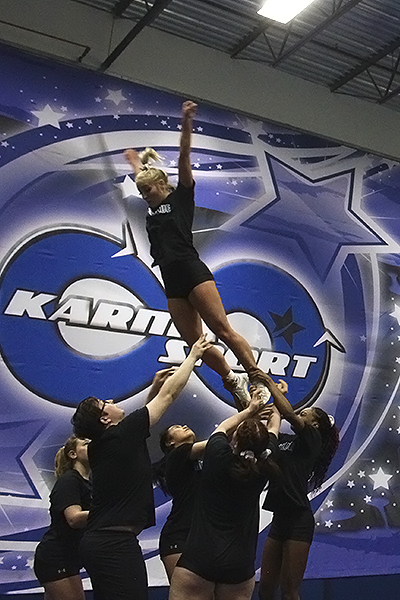
Ethier and other flyers have to put complete trust in their teammates when conducting stunts. As she launches herself, her team prepares to catch so they can flow seamlessly into the next phase of the routine. Photo by Eithne Lynch.
“When they hit the floor, it’s hard. There’s no spring to absorb the shock,” says Emond. “There will be sprains, there will be concussions because [the floor] doesn’t bounce. No matter how much we practice, it’s human error, it happens to them just as much as it does to a Worlds athlete who has so many years of experience under their belt.”
Boudreault can attest to this. She sprained her ankle during her second year of cheer and unfortunately, the injury never healed properly.
“My ankle is always unstable and I have to wear an ankle brace every time I do sports,” says Boudreault.
Although they practice a lot, college teams like Dawson have a shorter season than an all-star team like the one Boudreault is on. Dawson starts training in September with their first competition at the end of November.
All-star teams start their tryouts in June, and don’t compete until December. They train for five hours a week as a team, with members training outside of school either at tumbling gyms or by lifting weights.
The locations of the different cheerleading gyms in the Greater Montreal area. Media by Alexandre Ross.
Boudreault’s team trains three days per week, with each practice lasting two and a half hours.
All that training is boiled down into a two and half minute routine.
“You have to focus on that moment and you gotta focus on the ending and the routine and emotions come at the end,” says Samuel Lavallée, a member of the Dawson Cheer team.
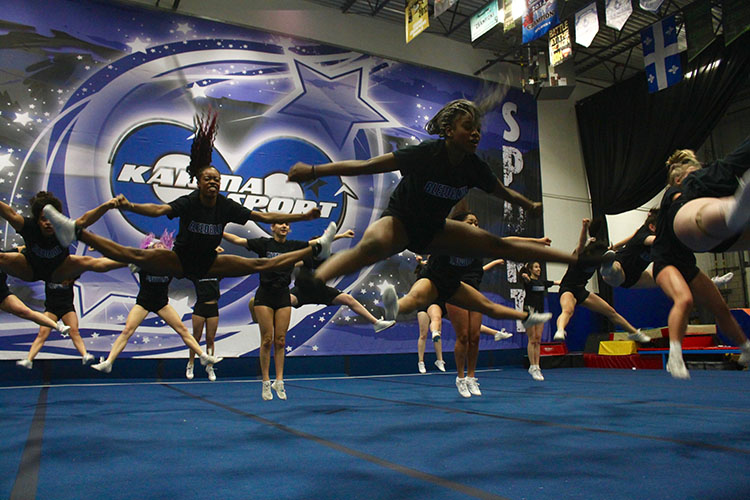
The Dawson team doesn’t practice their jumps and stunts at school. This means when they practice at a gym with a spring-floor, they have to give it all they’ve got. Photo by Eithne Lynch.
A typical competition day for Ethier starts at 5:30 in the morning . She gets to school by 6 a.m. with all equipment, pompoms and cones, ensuring that everyone on the team is present and ready.
After that they go to register. It’s there that they first come face-to-face with their competition.
“It’s like basketball when you see your rivals,” says Ethier. “Cheer is the same thing, it has the same effect.”
Then the team has to go for check-ups to ensure that everyone’s nails are trimmed to avoid scratching, and that no one has bobby-pins in their hair, because it could be a safety hazard if they fall and to ensure that all jewelry is removed.
Then it’s time to warm-up.
“After that, we go behind the curtain, we do our scream, we pump each other up,” says Ethier.
“I look on competition days like I’m the most relaxed person but that’s years of coaching experience where my anxiety and stress appear on the inside and I’ll take it out later,” adds Emond. “I have no control over what they end up doing on the mat.”
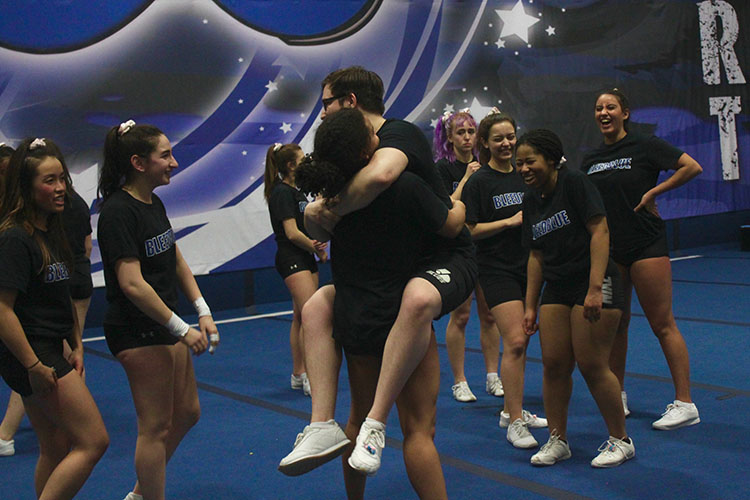
The Dawson team takes a moment to have fun between running sequences of their routine. Photo by Eithne Lynch.
“It’s a lot of nerves but in the end, it’s really worth it. That two and a half minutes is amazing,” said Lavallée. Unfortunately, despite all the hard work they’ve put into training so far, the Dawson team and cheer teams across the world have had to hit pause.
The cheerleading season is not like other sports. In sports like soccer or football, they have multiple opportunities to compete, show they’re skills and climb in rankings. Cheerleaders train for months on end before competing, then it comes down what they do on the mat. There’s no redo, no “we’ll get ‘em next time” attitudes. You have a few competitions to make your mark before your season is done.
The competitive cheer season was supposed to be underway in the next couple of months but with the spread of the COVID-19 virus, many practices and competitions have been cancelled or postponed. Fortunately for Boudreault, The Cheerleading Worlds competition is one that has been postponed rather than cancelled.
“The virus has completely changed the schedule of the rest of the season,” says Boudreault. “[The Cheerleading Worlds] is the event that we train for all year so it’s kind of great news but a little bit sad that it’ll be a month later than usual.”
At the collegiate level, everything is at a standstill. “With the school closures we are also not allowed to practice. RSEQ has cancelled the remainder of the season,” says Emond.
It’s the end of an era for the Montreal Alouettes cheerleaders. Video by Alexandre Ross.
